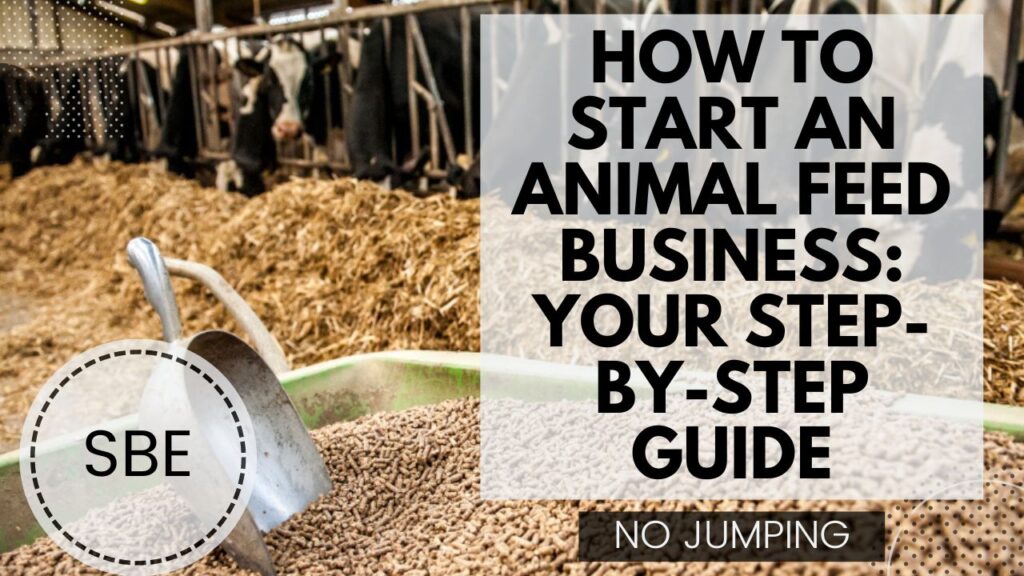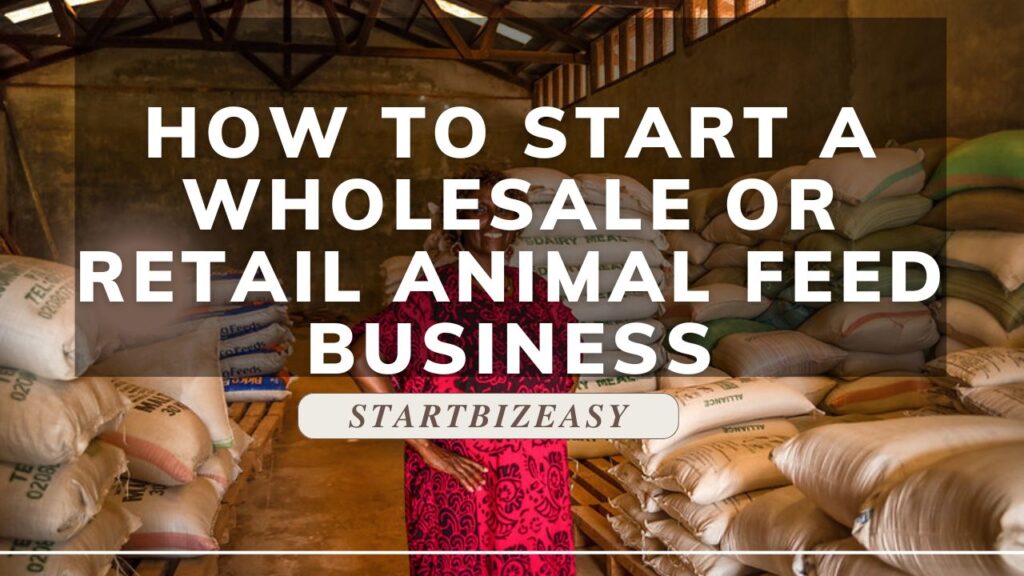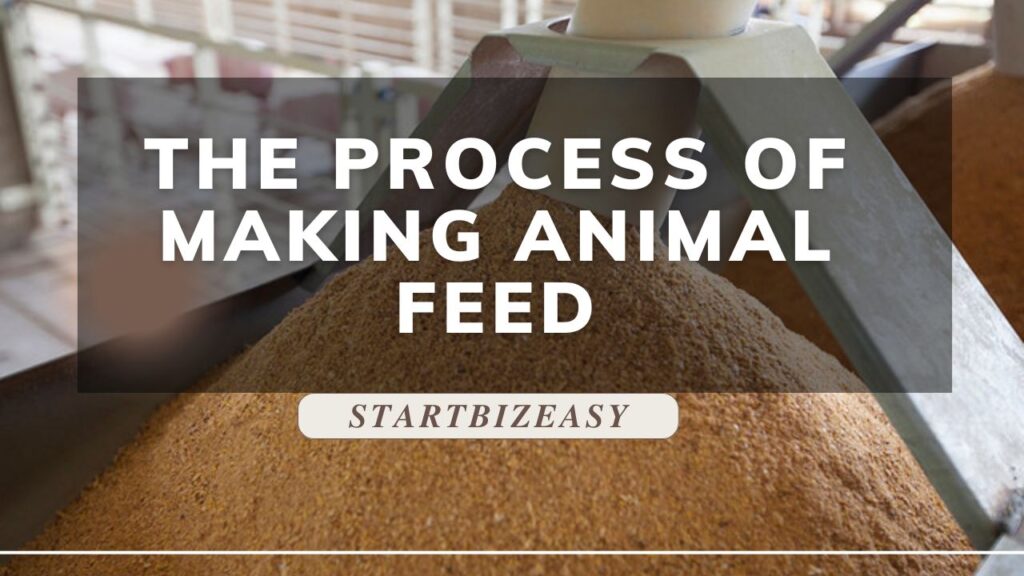
The animal feed business is a specialized sector within the agriculture industry that focuses on the production, distribution, and sale of food specifically formulated for livestock and domestic animals. This industry plays a crucial role in the food supply chain by ensuring that animals receive the necessary nutrients to grow, reproduce, and produce food products for human consumption, such as meat, milk, and eggs.
The process begins with the sourcing of raw materials, which include grains, proteins, vitamins, and minerals. These ingredients are carefully selected and blended to create balanced diets tailored to the specific needs of different animal species, such as poultry, cattle, swine, and fish. The formulation of these feeds requires a deep understanding of animal nutrition, biology, and the specific dietary requirements of each species at various stages of their life cycle.
Once the feed is formulated, it is manufactured using sophisticated processes that ensure consistency, quality, and safety. This often involves grinding, mixing, pelleting, and packaging the feed. Quality control measures are strictly adhered to, as the health and productivity of livestock depend heavily on the quality of their feed.
The distribution aspect of the animal feed business involves transporting the finished products to farms, retail stores, and other points of sale. This requires a well-organized logistics network to ensure timely and efficient delivery, minimizing the risk of spoilage and maintaining the nutritional value of the feed.
In this article, we are going to focus on two aspects of the animal feed business;
- How to start the manufacturing of Animal Feed Business
- How to Start the Distribution and Sales of Animal Feed
Whichever category you choose to settle for the animal feed business is a very profitable and lucrative business to start in Nigeria.
Table of Contents
How to Start the Manufacturing of Animal Feed Business

1. Decide the Animal Feed or Feeds You Will Be Manufacturing
To begin your journey in the animal feed manufacturing business, you must first decide which types of animal feed you will produce. This decision is foundational and should be based on several critical factors: your expertise, market demand, and the resources available to you.
Evaluate Your Expertise: Consider your background and knowledge in animal nutrition. If you have extensive experience with poultry, for instance, you might find it advantageous to start with poultry feed. Alternatively, if your expertise lies in cattle nutrition, focusing on cattle feed could be a more strategic choice. Leveraging your expertise ensures that you can create high-quality, nutritionally balanced feed that meets the specific needs of the animals.
Assess Market Demand: Conduct thorough market research to understand the demand for different types of animal feed in your target area. Identify which sectors—such as poultry, cattle, or pet food—have the highest demand and potential for growth. Analyzing trends and customer preferences will help you determine which types of feed are most likely to be successful. For example, if there is a growing trend towards organic or specialty feeds, you might consider entering that niche.
Consider Available Resources: Examine the resources at your disposal, including raw materials, production facilities, and financial capital. Some types of feed may require more specialized ingredients or equipment. Ensure that you have access to the necessary resources to produce the feed types you are considering. For instance, producing high-quality pet food may require different ingredients and more stringent quality control compared to standard livestock feed.
Understand Nutritional Requirements: Understanding the specific nutritional requirements of the animals you are targeting is crucial for creating effective and high-quality feed products. Each type of animal has unique dietary needs, and your feed formulations must meet these requirements to ensure optimal health and productivity. Consult with animal nutritionists and conduct extensive research to develop feed that provides the right balance of proteins, vitamins, minerals, and other essential nutrients.
Decide on Product Range: Based on your expertise, market demand, and available resources, decide whether you will focus on a single type of feed or a combination of various types. Offering a diverse product range can help you capture a broader market, but it also requires more complex production processes and resource management. Weigh the pros and cons of diversification versus specialization to make an informed decision.
By focusing on these factors, you can make strategic decisions that position your business for success in the competitive animal feed industry.
2. Market Research and Business Plan
Starting your animal feed manufacturing business begins with a crucial step: conducting thorough market research and developing a comprehensive business plan. This foundational phase will guide your decisions and set the stage for your success.
Market Research:
To begin, you must understand the demand for animal feed in your target area. This involves identifying potential customers, which can include farmers, livestock owners, and poultry farms. Engage with these groups to gather insights into their specific needs and preferences. What types of feed are they currently using? Are there any gaps in the market that you can fill? Understanding their requirements will help you tailor your products to meet their expectations.
Next, analyze the competition. Identify who your competitors are and what they offer. Study their pricing strategies, product quality, and customer service. Knowing what works and what doesn’t in the market will give you a competitive edge. Pay close attention to market trends as well. Are there emerging trends in animal nutrition or feed production that you can capitalize on? Staying informed about industry developments will help you stay ahead of the curve.
Business Plan:
Once you have gathered sufficient market data, use this information to create a comprehensive business plan. Your business plan should outline several key elements:
- Objectives: Clearly define what you aim to achieve with your business. This could include specific sales targets, market share goals, or milestones for product development.
- Target Market: Based on your research, identify your primary customer base. Detail the specific needs and characteristics of your target market segments, and explain how your products will meet their demands.
- Product Line: Describe the types of animal feed you will produce. Explain how your products will differ from those of your competitors and highlight any unique selling points, such as superior nutritional content or innovative formulations.
- Marketing Strategy: Develop a strategy for promoting your products. Outline the marketing channels you will use, such as social media, online advertising, agricultural trade shows, and local advertisements. Include plans for building brand awareness and engaging with your target customers.
- Financial Projections: Provide detailed financial projections, including startup costs, operating expenses, revenue forecasts, and profitability estimates. Include a break-even analysis and a timeline for achieving profitability. This section is crucial for securing funding, as it demonstrates the financial viability of your business.
Your business plan will serve as a roadmap for your business, guiding your decisions and helping you stay focused on your goals. It is also an essential tool for securing funding, whether you seek bank loans, investor funding, or other financing options. By presenting a well-researched and detailed business plan, you will increase your chances of attracting the necessary financial support to bring your vision to life.
By conducting thorough market research and developing a comprehensive business plan, you lay a solid foundation for your animal feed manufacturing business. This preparation will equip you with the knowledge and strategy needed to navigate the challenges and seize the opportunities in the market, setting you on a path to success.
3. Legal Requirements and Permits
Ensure that you comply with all local, state, and national regulations governing the production and sale of animal feed. Obtain the necessary licenses and permits, including business registration, manufacturing licenses, health and safety permits, and environmental clearances. Compliance with regulatory standards is crucial to avoid legal issues and ensure the quality and safety of your products.
4. Secure Funding
The cost to start an animal feed manufacturing business in Nigeria can vary significantly depending on the scale of operations, the type of equipment, and other factors such as location and raw materials. For a small-scale operation, the initial investment required ranges from ₦4,700,000 to ₦11,500,000. For a medium to large-scale operation, you will need an investment ranging from ₦23,800,000 to ₦67,000,000.
This capital will be spent on the following items:
- Facility and Office Location
- Business legal considerations
- Market Research
- Equipment
- Raw Materials
- Staffing
- Operational Expenses
In addition to these factors where your capital will be spent, there are key considerations you must be aware of that can significantly affect the cost of starting your feed manufacturing business. They are:
- Economies of Scale: Larger-scale operations may benefit from economies of scale, reducing per-unit costs.
- Quality of Raw Materials: The cost can vary depending on the quality and type of raw materials sourced.
- Location: Costs can vary based on the location within Nigeria, with urban areas typically being more expensive than rural areas.
- Technological Investment: Investing in more advanced technology can increase initial costs but improve efficiency and product quality.
Once you have determined the exact capital requirements, you need to explore various financing options to secure the necessary funds. Consider the following options:
- Bank Loans: Approach banks and financial institutions to apply for business loans. Present your business plan, highlighting your market research, financial projections, and the potential profitability of your venture. A well-prepared business plan will demonstrate your credibility and increase your chances of securing a loan.
- Investor Funding: Seek out potential investors who are interested in the agricultural or animal feed industry. These could be venture capitalists, angel investors, or even industry-specific investment firms. Present your business plan to them, emphasizing the growth potential and return on investment. Be prepared to negotiate terms and possibly offer equity in your business in exchange for funding.
- Personal Savings: If you have personal savings, consider investing them in your business. This option allows you to retain full control and ownership. However, ensure that you do not deplete your savings to the point of financial insecurity.
- Grants and Subsidies: Research available government grants and subsidies for agricultural businesses. Some programs offer financial support to promote innovation and sustainability in the agricultural sector. Applying for such grants can provide you with additional funds without the burden of repayment.
When seeking funding, your business plan is your most powerful tool. It demonstrates to potential investors or lenders that you have thoroughly researched the market, developed a sound strategy, and carefully planned your financial projections. Ensure your business plan is clear, concise, and professionally presented.
Highlight the following aspects when presenting your business plan:
- Market Opportunity: Emphasize the demand for animal feed in your target market and how your products will meet this demand.
- Competitive Advantage: Showcase what sets your business apart from competitors, such as superior product quality, innovative formulations, or unique market insights.
- Financial Projections: Provide detailed financial forecasts, including revenue projections, profit margins, and break-even analysis. This will help potential investors or lenders understand the financial viability of your business.
- Risk Mitigation: Address potential risks and outline your strategies for mitigating them. This demonstrates your preparedness and ability to manage challenges.
By effectively presenting your business plan, you can secure the necessary funding to start your animal feed manufacturing business.
5. Location and Facility Setup
Choosing the right location for your manufacturing facility is a crucial step in establishing your animal feed business. Here’s how you should approach this important decision:
Select an Accessible Location: Begin by selecting a location that is strategically situated to facilitate easy access to your raw material suppliers and target market. Proximity to suppliers ensures timely delivery of ingredients, which is vital for maintaining production schedules and managing inventory efficiently. Additionally, being close to your target market can reduce transportation costs and improve distribution efficiency.
Ensure Compliance with Zoning Regulations: Verify that your chosen location complies with local zoning regulations. Zoning laws dictate how land can be used and ensure that your manufacturing facility operates in an area designated for industrial or commercial purposes. This compliance is essential to avoid legal issues and potential disruptions to your business operations.
Design an Optimal Facility Layout: Design the layout of your facility to enhance the efficiency of your production process. Plan your facility layout to streamline the flow of materials from raw ingredient intake to final product packaging. This includes arranging production areas, storage spaces, and distribution zones in a logical sequence to minimize handling time and reduce the risk of contamination.
Install Necessary Machinery and Equipment: Equip your facility with the essential machinery and equipment needed for animal feed production. This typically includes:
- Grinders: For processing raw materials into smaller, manageable sizes.
- Mixers: To blend ingredients uniformly and create a consistent feed product.
- Pellet Mills: For shaping and compressing feed into pellets.
- Packaging Machines: To package the final product efficiently and securely.
Ensure that the machinery you choose is suitable for the scale of your production and meets industry standards for quality and safety.
Implement Proper Facility Infrastructure: Your facility must include proper infrastructure to support smooth operations:
- Ventilation: Install an effective ventilation system to maintain air quality and control dust, which is crucial for both employee safety and equipment maintenance.
- Lighting: Ensure adequate lighting throughout the facility to enhance visibility and safety in all areas of operation.
- Waste Disposal Systems: Set up efficient waste disposal systems to handle production by-products and maintain a clean, safe environment.
6. Sourcing Raw Materials
When starting your animal feed manufacturing business, sourcing raw materials is a critical step that requires careful consideration and planning. Here’s how you should approach this process:
Identify Reliable Suppliers: Begin by identifying reliable suppliers who can provide high-quality raw materials essential for your feed production. These materials typically include grains, oilseeds, vitamins, and minerals. Conduct thorough research to find suppliers who are known for their reliability, quality, and consistency. Evaluate their track record, customer reviews, and certifications (if possible) to ensure they meet industry standards.
Establish Strong Relationships: Develop and maintain relationships with multiple suppliers to ensure a steady and reliable supply of raw materials. Establishing relationships with more than one supplier helps mitigate the risk of supply disruptions due to unforeseen circumstances, such as natural disasters or market fluctuations. Additionally, having multiple suppliers allows you to compare prices and negotiate better terms, which can be beneficial for managing your production costs effectively.
Negotiate Competitive Pricing: Work on negotiating competitive pricing with your suppliers. As a new business, you may need to start with smaller quantities and gradually increase your orders as your business grows. Use your established relationships to negotiate favorable terms, such as bulk discounts or long-term contracts, which can help reduce your overall material costs.
Implement Stringent Quality Control Measures: Quality control is paramount to ensure that your feed products are safe and effective. Implement stringent quality control measures to assess and verify the quality of the raw materials you receive. This may include:
- Regular Testing: Conduct regular testing of raw materials for purity, nutritional content, and contamination.
- Supplier Audits: Perform audits of your suppliers’ facilities and processes to ensure they adhere to quality standards.
- Documentation: Maintain detailed records of all raw materials, including their sources, testing results, and any quality control measures taken.
This approach will help you produce feed products that meet the highest standards of safety and effectiveness, ultimately contributing to the success and reputation of your business.
7. Production Process
To successfully launch and operate your animal feed manufacturing business, you need to focus on establishing an efficient and effective production process. This involves several key steps:
Your first step is to invest in high-quality machinery and equipment. Essential equipment for the production process includes:
- Grinders: These are crucial for breaking down raw materials into smaller, manageable sizes.
- Mixers: Use mixers to combine ingredients thoroughly, ensuring a uniform blend.
- Pellet Mills: These machines convert the mixed feed into pellets, which are easier for animals to consume and digest.
- Drying Equipment: Drying equipment helps remove moisture from the feed, extending its shelf life and preventing spoilage.
- Packaging Machines: Invest in reliable packaging machines to ensure your feed is properly sealed and protected during transportation and storage.
Selecting high-quality equipment will improve your production efficiency, product consistency, and overall business performance.
Next, you need to hire skilled personnel to manage and operate your production facility. Key roles include:
- Production Managers: Responsible for overseeing the entire production process, ensuring that operations run smoothly and efficiently.
- Machine Operators: Operate and maintain the machinery and equipment, ensuring that it functions correctly and safely.
- Quality Control Experts: Monitor the quality of the raw materials and finished products, conducting tests and inspections to ensure that your feed meets industry standards and nutritional requirements.
- Administrative Staff: Handle administrative tasks such as record-keeping, procurement, and coordination of various operations within the facility.
Hiring the right people is crucial to maintaining a high standard of production and ensuring that your business runs effectively.
Once you have assembled your team, provide comprehensive training to ensure they understand every aspect of the production process. This training should cover:
- Production Procedures: Teach your staff the proper procedures for operating machinery, mixing ingredients, and packaging products.
- Quality Control Measures: Educate your quality control experts on how to perform inspections and tests to maintain product quality.
- Safety Protocols: Ensure that all employees are aware of and follow safety protocols to prevent accidents and ensure a safe working environment.
Effective training will help your team perform their roles efficiently and reduce the risk of errors or accidents.
Develop Balanced and Nutritious Feed Formulations: Work with animal nutrition experts to develop balanced and nutritious feed formulations. This involves:
- Tailoring Formulations: Create feed formulations that are specifically designed to meet the nutritional needs of different types of livestock and poultry. This may include adjusting ingredient ratios based on the age, weight, and type of animal.
- Using Quality Ingredients: Ensure that all ingredients used in your formulations are of high quality and meet the required nutritional standards.
Developing effective feed formulations is essential for ensuring the health and productivity of the animals that consume your feed.
By focusing on these aspects of the production process, you will be able to establish a reliable and efficient animal feed manufacturing operation. This will not only enhance the quality of your products but also contribute to the overall success of your business.
8. Marketing and Distribution
Create a marketing strategy to promote your animal feed products. Utilize various channels such as social media, online advertising, agricultural trade shows, and local advertisements. Highlight the nutritional benefits, quality, and safety of your products to attract customers. Develop an efficient distribution network to deliver your products to customers. This may involve working with wholesalers, retailers, and direct sales to farms. Ensure timely delivery and maintain the freshness and quality of the feed during transportation. Build strong relationships with your clients through excellent customer service and support.
How to Start the Distribution and Sales of Animal Feed

Successfully distributing and selling your animal feed products is crucial for the growth and sustainability of your business. Here’s a step-by-step guide to help you establish an efficient distribution network and an effective sales strategy:
1. Identify Your Target Market
First, you need to clearly identify your target market. This includes:
- Farmers: Small and large-scale farmers who rear livestock and poultry.
- Livestock Owners: Individuals who own cattle, pigs, goats, sheep, and other livestock.
- Poultry Farms: Farms that specialize in raising chickens, ducks, turkeys, and other poultry.
- Retailers: Agricultural supply stores and feed shops that sell to end consumers.
- Distributors: Companies that can distribute your feed products to various regions.
Understanding your target market helps you tailor your distribution and sales efforts to meet their specific needs.
2. Develop a Distribution Network
Establishing a robust distribution network is essential for ensuring that your products reach your customers efficiently and on time. Consider the following steps:
- Direct Sales: Sell directly to farmers and livestock owners. This approach allows you to build strong relationships with your customers and receive direct feedback.
- Wholesalers and Distributors: Partner with wholesalers and distributors who can help you reach a wider market. These intermediaries can handle large orders and distribute your products to various retail outlets.
- Retail Outlets: Place your products in agricultural supply stores and feed shops. Ensure that these outlets are easily accessible to your target customers.
- Online Sales: Develop an online sales platform where customers can place orders. This can be a website or an e-commerce platform that provides detailed information about your products and allows for easy purchasing.
3. Logistics and Transportation
Efficient logistics and transportation are critical for maintaining the quality of your animal feed products. Consider the following:
- Transportation: Invest in reliable transportation methods to ensure timely delivery. This may include your own fleet of vehicles or partnering with a logistics company.
- Storage: Ensure that your products are stored in a clean, dry, and pest-free environment to maintain their quality and shelf life.
- Inventory Management: Implement an effective inventory management system to keep track of stock levels, monitor product expiration dates, and manage orders efficiently.
4. Marketing Strategy
Develop a comprehensive marketing strategy to promote your animal feed products. This should include:
- Branding: Create a strong brand identity that highlights the quality and benefits of your products. Use attractive packaging and consistent branding across all marketing materials.
- Advertising: Utilize various advertising channels such as social media, online ads, local newspapers, agricultural magazines, and radio spots to reach your target audience.
- Promotions: Offer promotions, discounts, and special deals to attract new customers and retain existing ones. Consider offering samples to potential customers to encourage them to try your products.
- Trade Shows and Events: Participate in agricultural trade shows, fairs, and other industry events to showcase your products and connect with potential customers.
5. Customer Service
Providing excellent customer service is essential for building long-term relationships with your clients. Focus on the following:
- Communication: Maintain open lines of communication with your customers. Address their inquiries and concerns promptly and professionally.
- Feedback: Encourage customer feedback to understand their needs and improve your products and services.
- Support: Offer technical support and advice on the best feeding practices and how to maximize the benefits of your feed products.
6. Monitor and Adjust
Continuously monitor your distribution and sales performance. Analyze sales data, customer feedback, and market trends to identify areas for improvement. Be prepared to adjust your strategies as needed to respond to changes in the market and meet customer demands.
By following these steps, you can effectively distribute and sell your animal feed products, ensuring they reach the right customers and contribute to the growth and success of your business.
How to Start a Wholesale or Retail Animal Feed Business

Starting a wholesale or retail animal feed business in Nigeria is a promising venture that caters to the agricultural sector, ensuring that livestock and poultry farmers have access to quality feed. Here’s a step-by-step guide to help you establish your business successfully:
1. Conduct Market Research
To begin, conduct thorough market research to understand the demand for animal feed in your target area. Identify potential customers, such as livestock farmers, poultry farms, and agricultural supply stores. Assess the competition, analyze pricing strategies, and study market trends. This information will help you make informed decisions and tailor your offerings to meet market needs.
2. Develop a Business Plan
Create a comprehensive business plan outlining your objectives, target market, product range, marketing strategy, and financial projections. Your business plan should include:
- Business Objectives: Clearly define your short-term and long-term goals.
- Target Market: Identify your primary customers and their specific needs.
- Product Range: Determine the types of animal feed you will offer, such as poultry feed, cattle feed, or specialized feeds.
- Marketing Strategy: Develop a plan for promoting your business and attracting customers.
- Financial Projections: Estimate your startup costs, operating expenses, and revenue projections.
A well-crafted business plan will serve as a roadmap for your business and help you secure funding if needed.
3. Secure Funding
The cost of starting a wholesale animal feed business in Nigeria ranges from ₦11,500,000 to ₦22,700,000, while for retailers, the cost ranges from ₦2,850,000 to ₦7,450,000. You need to determine and conclude the exact amount of funds required to start your own animal feed business, whether it is wholesale or retail. This includes funds for purchasing inventory, renting a location, and covering operational expenses. Explore various financing options such as bank loans, investor funding, or personal savings. Present your business plan to potential investors or lenders to secure the necessary funds.
4. Choose a Suitable Location
Select a strategic location for your business that is easily accessible to your target customers. For a wholesale business, consider a location near livestock farms or in an agricultural hub. For a retail business, choose a spot in a busy market area or close to agricultural supply stores. Ensure that the location has adequate storage facilities to keep your feed products in good condition.
5. Obtain Necessary Licenses and Permits
Ensure that you comply with all local regulations and obtain the necessary licenses and permits to operate your business legally. This include business registration, health and safety permits, and environmental clearances. Compliance with regulatory standards is crucial to avoid legal issues and ensure the quality and safety of your products.
6. Establish Supplier Relationships
Identify reliable suppliers who can provide high-quality animal feed at competitive prices. Establish strong relationships with these suppliers to ensure a steady and consistent supply of products. Negotiate favorable terms and consider bulk purchasing to reduce costs.
7. Set Up Your Facility
For both wholesale and retail businesses, setting up an efficient and organized facility is essential. This includes:
- Storage: Ensure that your storage area is clean, dry, and pest-free to maintain the quality of the feed.
- Inventory Management: Implement an inventory management system to keep track of stock levels, monitor product expiration dates, and manage orders efficiently.
- Staffing: Hire knowledgeable and experienced staff to handle sales, customer service, and inventory management. Provide training to ensure they understand your products and can assist customers effectively.
8. Develop a Marketing Strategy
Promote your business through various marketing channels to attract customers. Your marketing strategy should include:
- Branding: Create a strong brand identity that highlights the quality and benefits of your products.
- Advertising: Use social media, online ads, local newspapers, agricultural magazines, and radio spots to reach your target audience.
- Promotions: Offer promotions, discounts, and special deals to attract new customers and retain existing ones.
- Networking: Attend agricultural trade shows, fairs, and industry events to showcase your products and connect with potential customers.
9. Provide Excellent Customer Service
Building strong relationships with your customers is key to the success of your business. Focus on providing excellent customer service by:
- Communication: Maintain open lines of communication with your customers. Address their inquiries and concerns promptly and professionally.
- Feedback: Encourage customer feedback to understand their needs and improve your products and services.
- Support: Offer technical support and advice on the best feeding practices and how to maximize the benefits of your feed products.
10. Monitor and Adjust
Continuously monitor your business performance. Analyze sales data, customer feedback, and market trends to identify areas for improvement. Be prepared to adjust your strategies as needed to respond to changes in the market and meet customer demands.
By following these steps, you can successfully start and grow a wholesale or retail animal feed business in Nigeria. This venture not only supports the agricultural sector but also ensures that livestock and poultry farmers have access to quality feed, ultimately contributing to food security and the agricultural economy.
The Raw Materials for Animal Feeds
The raw materials for animal feed are diverse and selected based on the nutritional needs of the target animals. Here is a comprehensive list of common raw materials used in animal feed production:
1. Cereals and Grains
- Corn (Maize): A primary energy source rich in carbohydrates.
- Wheat: Provides energy and proteins, commonly used in poultry and swine feeds.
- Barley: Offers energy and fiber, often used in ruminant feeds.
- Oats: High in fiber, beneficial for ruminants and horses.
- Sorghum: An alternative to corn, providing energy and some proteins.
2. Oilseeds and Legumes
- Soybean Meal: A key protein source, high in essential amino acids.
- Canola Meal: Another protein-rich ingredient with a good amino acid profile.
- Peanut Meal: High in protein, used in various animal feeds.
- Cottonseed Meal: Provides protein and fiber, commonly used in cattle feed.
- Sunflower Meal: Rich in proteins and fiber, used in poultry and livestock feeds.
3. Animal Protein Sources
- Fish Meal: High in protein and essential fatty acids, often used in aquaculture and poultry feeds.
- Meat and Bone Meal: Provides protein, calcium, and phosphorus, commonly used in poultry and swine feeds.
- Blood Meal: Extremely high in protein, used in limited quantities due to its strong flavor.
4. Fats and Oils
- Vegetable Oils: Such as soybean oil, canola oil, and corn oil, provide energy and essential fatty acids.
- Animal Fats: Including lard and tallow, used to increase energy density in feeds.
5. Fiber Sources
- Alfalfa Meal: Rich in protein and fiber, used in ruminant and poultry feeds.
- Wheat Bran: Provides fiber and some protein, often used in cattle and swine feeds.
- Rice Bran: Offers fiber and energy, used in various animal feeds.
6. Vitamins and Minerals
- Vitamin Premixes: Blended to meet the specific dietary requirements of different animals.
- Mineral Supplements: Such as calcium carbonate, dicalcium phosphate, and salt, ensure animals receive essential minerals.
- Trace Minerals: Including zinc, manganese, iron, copper, and selenium, added in small amounts to support overall health.
7. Additives and Supplements
- Amino Acids: Such as lysine, methionine, and threonine, added to improve the protein quality of the feed.
- Enzymes: To enhance digestibility and nutrient absorption.
- Probiotics and Prebiotics: To support gut health and improve feed efficiency.
- Antibiotics: Used in some regions to promote growth and prevent disease, though their use is regulated and sometimes restricted.
- Antioxidants: To preserve feed quality and extend shelf life.
- Flavor Enhancers: To improve palatability and encourage feed intake.
8. By-Products
- Distillers Grains: A by-product of ethanol production, rich in protein and fiber.
- Brewers Grains: A by-product of beer brewing, used in ruminant feeds.
- Molasses: A by-product of sugar production, used to enhance flavor and provide energy.
By carefully selecting and blending these raw materials, you can formulate balanced and nutritious animal feeds tailored to the specific needs of different animal species, ensuring their health and productivity.
The process of making animal feed involves several steps to ensure that the final product is nutritious, safe, and meets the specific dietary needs of the target animals. Here is a detailed overview of the animal feed manufacturing process:
The Process of Making Animal Feed

1. Formulation
Nutritional Requirements:
- Work with animal nutritionists to determine the specific nutritional requirements for the target animals (e.g., poultry, cattle, swine, pets).
- Create feed formulas that balance proteins, carbohydrates, fats, vitamins, and minerals.
Ingredient Selection:
- Choose high-quality raw materials, such as grains, oilseeds, protein sources, vitamins, and minerals.
- Ensure the selected ingredients meet the desired nutritional profile and are free from contaminants.
2. Raw Material Procurement
Supplier Selection:
- Identify and establish relationships with reliable suppliers to ensure a steady supply of quality raw materials.
- Negotiate pricing and delivery terms to manage costs effectively.
Quality Control:
- Implement stringent quality control measures to inspect incoming raw materials.
- Conduct tests for moisture content, nutrient composition, and the presence of contaminants.
3. Grinding
Particle Size Reduction:
- Use grinders or hammer mills to reduce the size of raw materials.
- Achieve a uniform particle size to ensure consistent mixing and pellet quality.
Sieving:
- Sieve ground materials to remove any oversized particles or impurities.
- Ensure a consistent and fine particle size suitable for mixing.
4. Mixing
Batch Mixing:
- Use batch mixers to combine different raw materials according to the feed formula.
- Ensure thorough mixing to achieve a homogeneous blend of ingredients.
Continuous Mixing:
- For larger operations, continuous mixers can be used for a more efficient mixing process.
5. Conditioning
Moisture Adjustment:
- Add water or steam to the mixed feed to achieve the desired moisture content.
- Conditioning helps to soften the feed particles and improve pellet quality.
Heat Treatment:
- Apply heat during conditioning to kill any harmful bacteria or pathogens.
- Ensure the feed is safe for consumption by animals.
6. Pelleting
Pellet Mill:
- Use a pellet mill to compress the conditioned feed mixture into pellets.
- Adjust the die size and compression settings to produce pellets of the desired size and shape.
Cooling:
- Cool the pellets immediately after pelleting to harden them and prevent spoilage.
- Use a pellet cooler to reduce the temperature and moisture content.
7. Crumbling (Optional)
Size Reduction:
- For young animals or specific feed types, use a crumbler to break the pellets into smaller particles.
- Achieve the desired particle size for easier consumption by young or smaller animals.
8. Screening
Quality Control:
- Use screening equipment to remove fines and dust from the pellets.
- Ensure that only uniform, high-quality pellets proceed to the next stage.
9. Packaging
Bagging:
- Package the finished feed into bags or bulk containers, depending on customer requirements.
- Use automated bagging systems for efficiency and accuracy.
Labeling:
- Label the packages with essential information, including the feed type, nutritional content, usage instructions, and expiration date.
- Ensure compliance with regulatory requirements for labeling.
10. Storage and Distribution
Storage:
- Store the finished feed in a clean, dry, and cool environment to maintain quality.
- Implement inventory management practices to track stock levels and prevent spoilage.
Distribution:
- Develop a distribution plan to deliver the feed to customers, which may include direct sales to farms, partnerships with distributors, and retail sales.
- Use reliable logistics and transportation services to ensure timely delivery.
By following these steps, you can produce high-quality animal feed that meets the nutritional needs of various animals, ensuring their health and productivity. Regular monitoring and quality control throughout the manufacturing process are essential to maintain consistency and safety in your feed products.





